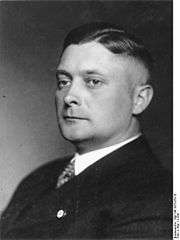Karl Kaufmann
| Karl Kaufmann | |
|---|---|
|
Karl Kaufmann | |
| Reichsstatthalter of Hamburg | |
|
In office 1933–1945 | |
| Preceded by | Office created |
| Succeeded by | Office abolished |
| Gauleiter of Hamburg | |
|
In office 1929–1945 | |
| Preceded by | Hinrich Lohse |
| Succeeded by | Office abolished |
| Personal details | |
| Born |
10 October 1900 Krefeld |
| Died |
4 December 1965 (aged 65) Hamburg |
| Nationality | German |
| Political party |
|
Karl Kaufmann (10 October 1900 in Krefeld[1] – 4 December 1965 in Hamburg) was a Nazi Gauleiter in Hamburg—head of the Nazi Party, and government of Hamburg from 1933 until 1945.
Early life
Kaufmann was born in Krefeld on 10 October 1900. He served as a war volunteer in World War I and in the Brigade Ehrhardt (1919–1920).[2]
Career
_(6983603002).jpg)
Photo: National Archives of Norway
A founding member of the NSDAP in 1921; after the re-establishment of the party, he rejoined in 1925 and quickly became one of Adolf Hitler's favourites. He was appointed Gauleiter of the Gaus Rheinland and Ruhr in 1922-29,[2] then Gauleiter of Hamburg in 1929, a post he was to hold until 1945. He was also member of the German Reichstag.[1] After Hitler gained power on 16 May 1933, Kaufmann was appointed Reichsstatthalter (Regional Governor) of Hamburg[3] with absolute power over some 1.8 million people. One of his first acts was to turn over control of the city's Fuhlsbüttel Prison to the SA and SS, where it quickly became the nucleus of the notorious Kola-Fu concentration camp.
In September 1941, after Allied bombing of Hamburg had rendered many people homeless, Kaufmann petitioned Hitler to allow him to deport local Jews so that he could confiscate their property to rehouse bombed-out citizens. Hitler quickly responded, allowing Kaufmann the dubious distinction of being the first Nazi leader to deport German Jews, in this instance to the Łódź Ghetto in Poland.
Adolf Hitler declared Hamburg as fortress, similar to the Festung Warschau, the cities of Poznań, or Kolberg. In April 1945, Kaufmann and Commander Generalmajor Alwin Wolz wanted, independently of each other, to capitulate without further struggle. After negotiations and the publication of a pamphlet prepared by Kaufmann—without Kaufmann's consent—Hamburg was declared open city by Admiral Karl Dönitz, then president of Germany.[4]
After the war
Arrested shortly after the occupation of Hamburg by British forces in 1945, in 1946 Kaufmann was witness at the Nuremberg Trials,[2] he was subsequently tried for war crimes and sentenced to a term of imprisonment, but released soon after on the grounds of ill health after an accident. He was to be arrested twice more before being finally released in 1953. Kaufmann died on 4 December 1965 in Hamburg.[2]
Apologetic account
In his book Das letzte Kapitel (The last chapter) published in 1947, Kurt Detlev Möller described Kaufmann as a "good Gauleiter", a "rebel against the leader", and the "rescuer of Hamburg", because of the capitulation without struggle of the city of Hamburg.[2]
References
- 1 2 "Datenbank der deutschen Parlamentsabgeordneten Basis: Parlamentsalmanache/Reichstagshandbücher 1867 - 1938" (in German). Bayerische Staatsbibliothek. Retrieved 2009-09-23.
- 1 2 3 4 5 Stubbe-da Luz, Helmut (2005). "Kaufmann, Karl". In Franklin Koplitzsch and Daniel Tilgner. Hamburg Lexikon (in German) (3 ed.). Ellert&Richter. p. 267. ISBN 3-8319-0179-1.
- ↑ "Erste Bürgermeister Hamburgs 1507-2008" (PDF) (in German). Senat der Freien und Hansestadt Hamburg, Senatskanzlei. Retrieved 2009-09-22.
- ↑ Verg, Erich; Verg, Martin (2007). Das Abenteuer das Hamburg heißt (in German) (4th ed.). Hamburg: Ellert&Richter. p. 182. ISBN 978-3-8319-0137-1.
External links
| Wikimedia Commons has media related to Karl Kaufmann. |
- Kaufmann, Karl in Der Deutsche Reichstag, Wahlperiode nach d. 30. Jan. 1933, Bd.: 1938, Berlin, 1938 (German)

.svg.png)